Most people don’t know that the same plant responsible for our coffee makes a great houseplant.
Its botanical name is Coffea arabica and it is an evergreen plant that develops white star-shaped flowers in spring that develop in the leaf axil of side shoots.
If you believe the University of Oxford, caffeine is the #1 legal stimulant worldwide.
We consume more than 100,000 tonnes globally from botanical sources such as coffee, chocolate, and tea.
Coffee plant care is easy and fulfilling.
The dark green glossy ruffled foliage of the Coffee plant is definitely attractive to look at.
It is long-lived and a vigorous grower.
And what better to stare at in the morning than looking at your beautiful coffee plant with your own cup of coffee in your hand?
The best thing, however, is that the care is easy as stated above.
The coffee plant or Coffea belongs to the family of Rubiaceae according to the Indiana University Bloomington, a genus of flowering plants with 90 different species.
Its seeds, also called coffee beans, are used for various beverages.
The most well-known is coffee.
But did you know that not only the seeds but also the fruits contain caffeine?
Coffee Plant Care
To care for a coffee plant use soil consisting of peat moss. Provide bright indirect light in an east or west-facing window spot if possible. Keep the soil slightly moist and reduce watering in winter. The temperature should be between 64°F – 75°F (18°C – 25°C). Humidity should be above 50%. Fertilize every 2-weeks with a fertilizer diluted to half-strength in spring and summer.
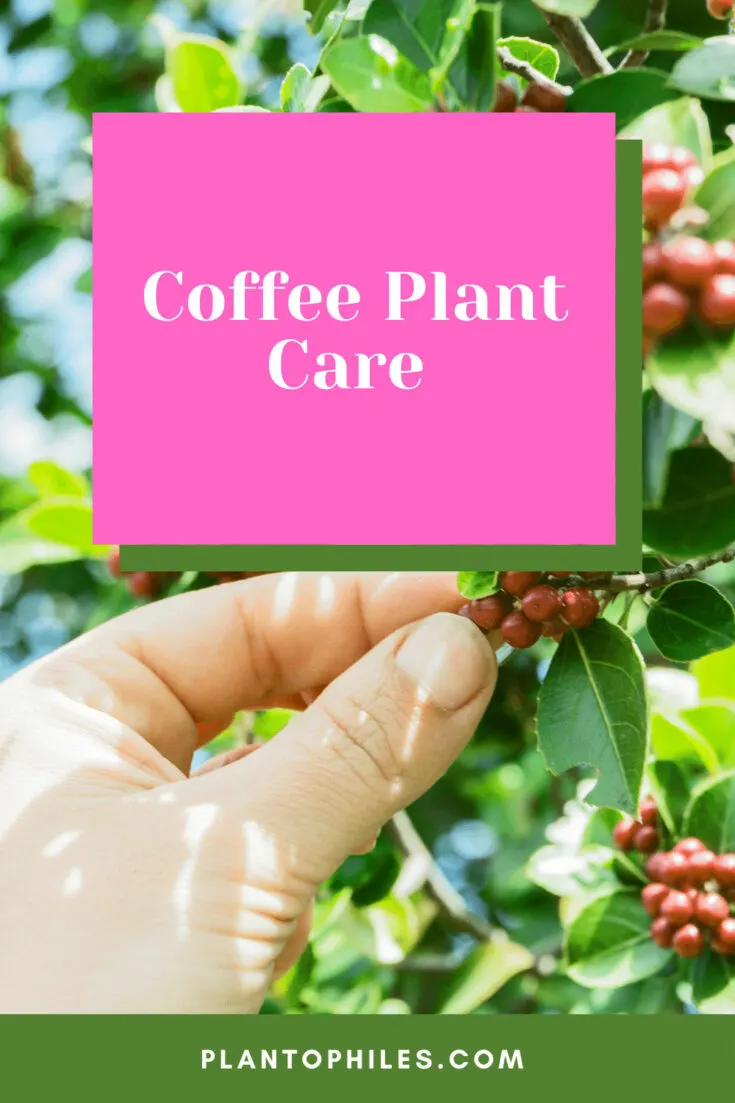
Coffee Plant Care
Table of Contents
Coffee Plant Care
Coffea arabica has been cultivated for over 1000 years in Arabia. It reaches the flowering stage within 3 to 4 years and then produces scented white flowers.
After the flowers, green beans will follow that then turn into red and brown-black as the ripening process sets in.
But let us now focus on why the Coffea arabica makes such a great houseplant by moving to the plant care sheet.
Soil
Horticultural sand with peat moss is the perfect soil mixture for a Coffee plant. Coffee plants prefer slightly acidic soil that mimics the condition they grow in the wild.
Coffea arabica is found in elevated tropical climates and needs well-draining soil. A pH level between 4.5 – 6 is considered ideal.
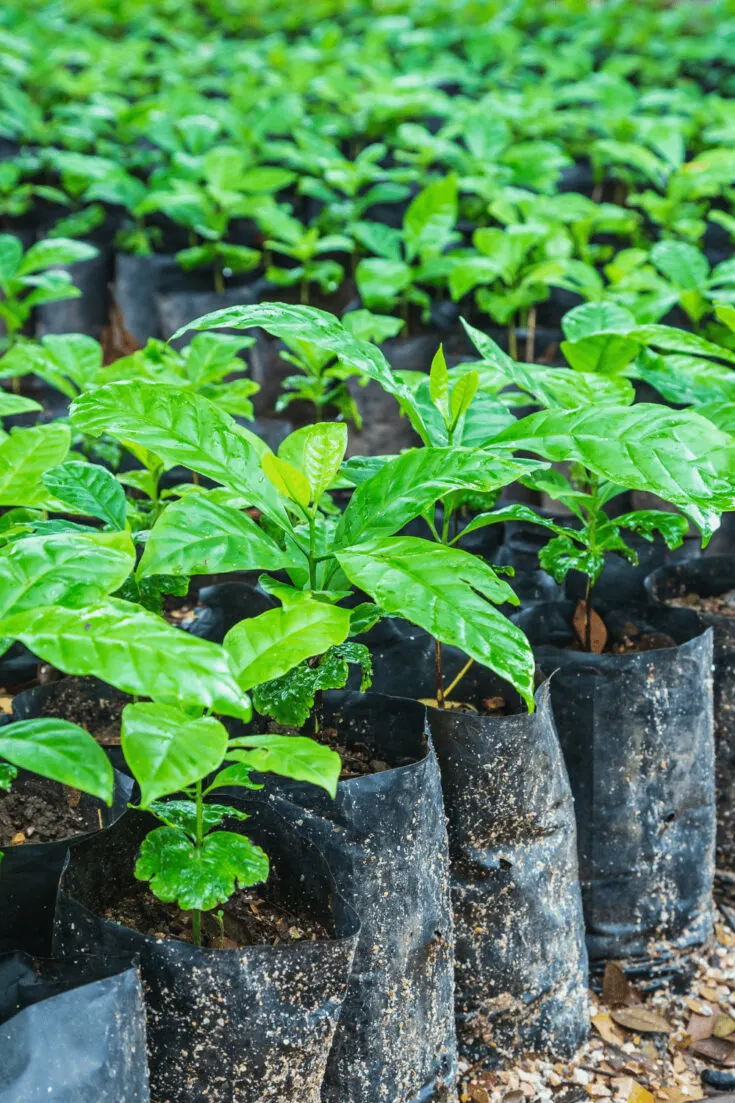
Horticultural sand and peat moss is a great soil mix for coffee plants
Light
The coffee plant likes bright indirect light.Place it close to a window and make sure that direct sunlight is not able to reach the plant for more than a couple of hours a day.
If you have direct sunlight touching your plant, make sure that it is in the morning as it may burn the leaves otherwise.
An east- or west-facing window is advised. A north-facing window will do as well.
Only place it in front of a south-facing window if you can filter the light or provide some kind of protection from the sun.
Watering
Moist but not soaking wet soil is the key to keeping the coffee plants happy. To achieve this you will need a pot with drainage holes as this is the only way you can ensure that your soil doesn’t stay too wet after watering.
Coffea arabica require plenty of water as a plant growing in rainforests.
Reduce watering in winter.
Water your plant thoroughly in Spring and Summer as this is where your Coffea arabica is in its growing phase.
Temperature
The ideal temperature for a coffee plant is between 64°F – 75°F (18°C – 25°C). Make sure temperature do not go below 64°F (18°C).
Coffea arabica can be grown outdoors in a hardiness zone between 6 and 11.
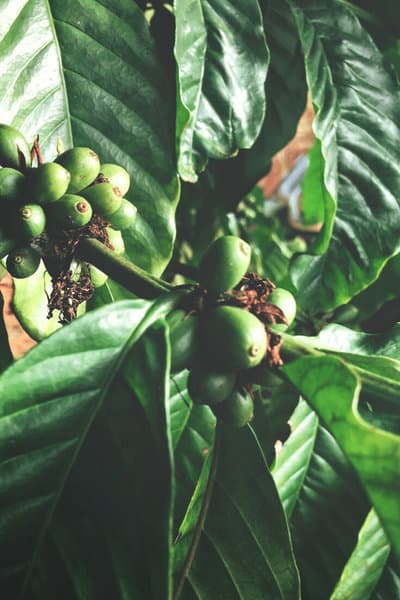
The ideal temperature for a coffee plant is 64°F – 75°F (18°C – 25°C)
Humidity
The ideal humidity for a coffee plant is 50% or more. Coffee plants love increased humidity as this mimics how they are growing in nature. Lower humidity levels will be tolerated, however.
Humidity is important. Placing your Coffea arabica either on a pebble tray that you can fill with water or misting daily is advised.
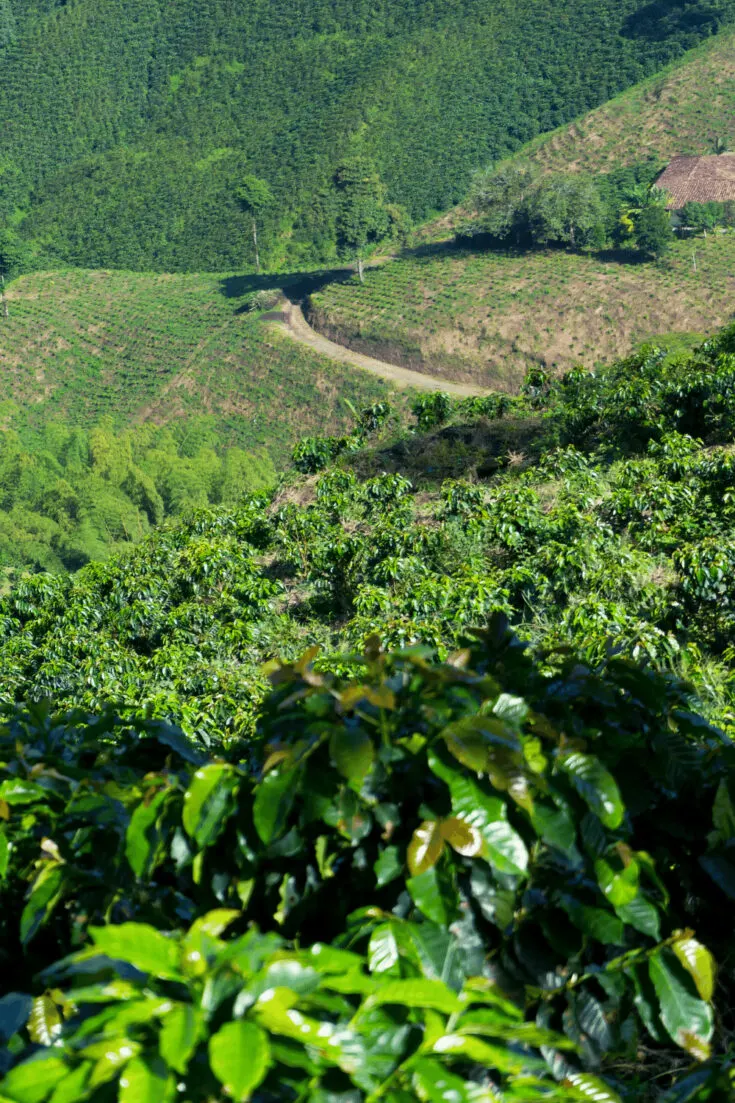
Coffee plants love humidity and grow best at a humidity above 50%
Fertilizer
Fertilize a coffee plant only in spring and summer and use a well-balanced fertilizer every second week. Dilute to half the recommended strength and reduce fertilizer use in winter to no more than once a month.
Do not fertilize in the first year of when just repotted. Check out our article on nutrients and fertilizer for more info.
Propagation
Coffee plants are best propagated from seeds whereas cuttings are more difficult to propagate. Every fruit will contain at least two seeds.
Seeds need to be fresh as the chances of bringing seeds to sprout are quickly vanishing within weeks.
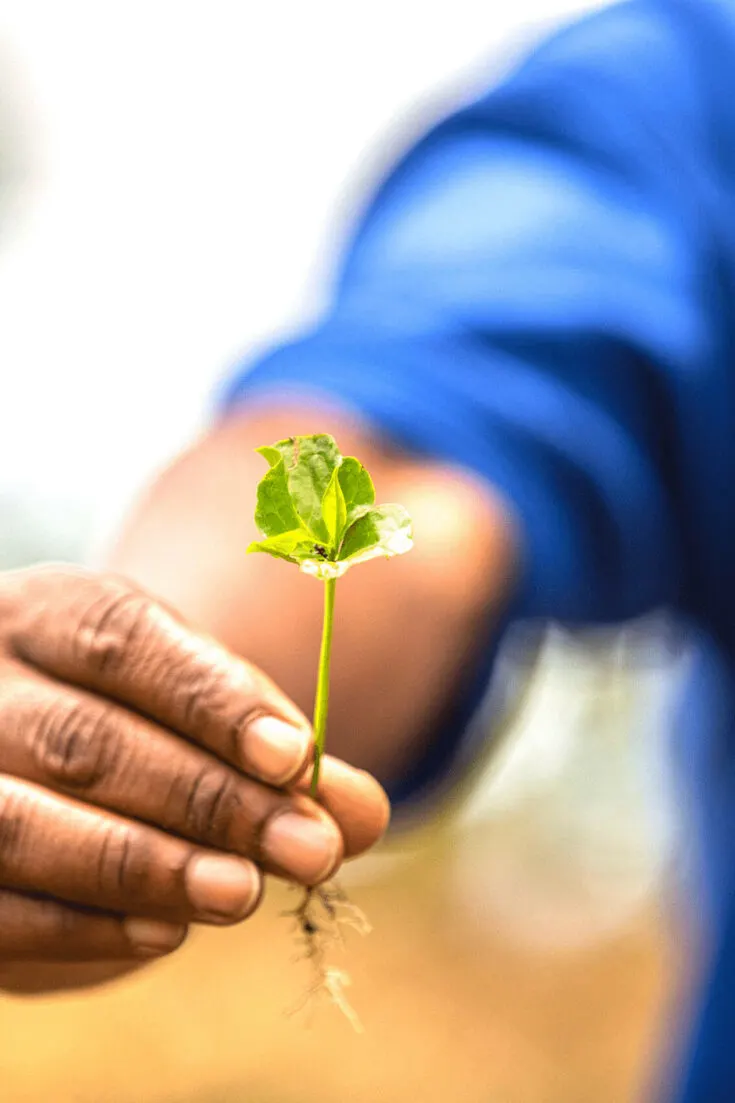
It is best to propagate coffee plants from seeds
Growth
Coffee plants grow up to 15 feet tall in nature (4.6m) and 6 feet as a houseplant (1.8m). They will grow up to a width of 3 feet (0.9m).
You can prune your plant any way you want as Coffea arabica will tolerate this without any signs of drooping or wilting.
On the contrary, can use your pruning sheers as a great way to have your plant look the way you want it to look.
Prune in spring if possible as this is when your plant is growing the best and you are not risking any major setbacks.
Furthermore, the more you cut off the top the bushier your plant will grow as it won’t need all the energy to grow higher.
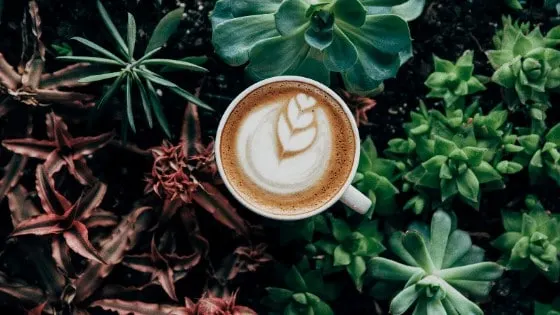
You will need about 3 ounces or 85 grams of coffee ground for one cup
Potting
Repot a coffee plant in spring when possible. Your second-best alternative is to repot in summer. Make sure that you increase pot size by no more than 1-2 sizes as the roots of your plant need to be able to grow with your pot. Too big a pot and you are likely to overwater.
If the pot is too small you are risking that your Coffea plant is becoming pot or root-bound. Coffea arabica are vigorous growers and develop strong root systems so repotting often is necessary. Spring generally is the best season to do so.
Propagating Coffee Plants
Coffee plant propagation is best done by sowing the seeds of the plant.
Each ripe fruit produces two seeds that can be harvested after the plants have produced blooms in spring.
This is hen followed by fruits that ripen from green to red to brown-black.
An alternative would be to use seedlings and grow them.
An additional method that is a bit more advanced is to grow new plants from cuttings. As coffee plants are shrubs that develop wooden stems, the propagation process takes somewhat longer compared to your average houseplant but it is possible.
The best approach is to take scions and place them directly into the soil.
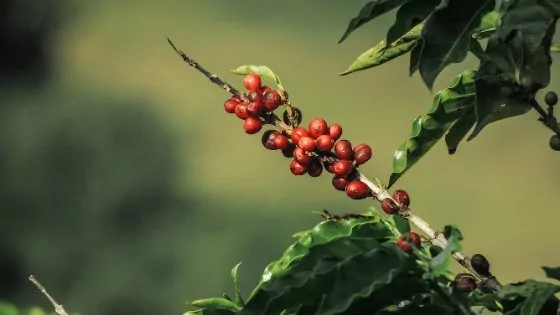
Coffee Plant Fruits. Each fruit procured two seeds (beans)
The best way to propagate your Coffee Plant
- The best way to grow Coffea arabica is from seeds. You will need the fruit of the plant which are the berries. These turn from green to a reddish colour before they become brown and black. You need to open the fruits and crack the shell. Laying the fruits into the water may help to crack them open.
- One you got the shell open it will contain two seeds that can be sown. Place the seeds into slightly moist soil. Slightly cover the seeds with about 0.8 inches or 2 centimetres of soil. Keep the soil moist but never soggy during the whole germination and prevent it from drying up.
- Make sure the temperature stays around 77 Fahrenheit (25 degrees Celcius) or above to ensure that the seeds germinate.
- Make sure your seeds and later on little plantlets are kept away from direct sunlight and are in partial shade.
- Be patient as germination can take several months. Sow preferably in spring or summer as your second-best season as the process might be prolonged or even fail in Autumn or Winter.
Propagating Coffee Plants using cuttings
- The best cutting for propagation to take on a Coffea arabica is scions. These are the top shoots. The best season to make the cuttings is early Summer and you should make sure that your cuttings are about 12 inches long (30 centimetres).
- Only leave the top leaves on your scion as you will not need the bottom leaves and you will need the bottom half to be placed into dirt. Too many leaves on the cutting would also mean that the plant to be would need too much energy to maintain all of the existing leaves. This would hinder the Coffea arabica cutting from producing roots.
- Stick the scions into moist potting soil and make sure to cover them in dirt. Make sure that no leaves are touching the ground and no leaf is submerged in soil.
- For increased humidity it is common practice to put some foil over the pot or place a bag on top of it. This will create a humidity dome and will increase the whole propagation process.
- Semi shade and a warm location with temperatures around and above 77 degrees Fahrenheit (25 degrees Celsius) is best.
- It may take several weeks before roots are starting to sprout. Enjoy the process and ensure that the soil is not drying out. Avoid overwatering at all costs as too much water might cause rot. If you overwater only once the whole endeavour might fail as you need to remember your cutting do not have any roots to take up water at this stage.
Meeting the water requirements of your Coffee Plant
The best way to water your Coffea arabica is to water it thoroughly. Make sure that you have well-draining soil and that you are using a pot with drainage holes.
Water more intense in Spring and Summer and reduce the amount of water as well as the frequency in Winter and Autumn.
The right water
Use chalk free water for your Coffea arabica and let your tap water sit for at least 24 hours before you use it to remove chlorine.
The right amount of water
The right amount of water for your Coffea arabica depends on many factors. The smaller your plant is the more water is needed.
Water you more mature plants less. In addition, the potting soil and how fast it is drying out and can retain water is a big factor as well as your indoor or outdoor temperature.
Coffea arabica hates soggy soil and also do not like to be too dry. They like the right amount of water that keeps them humid at all times. Avoid letting your plant dry.
Water your plants more in Summer than in Winter as in the growing seasons Spring and Summer the plants need more water to account for growth.
Common problems exhibited by Coffee Plants
Problem: Brown patches on the leaves.
Cause: Infrequent watering or lack of water or both.
Solution: Water regularly and soak your coffee plant in water.
Problem: Yellow leaves.
Cause: Chances are that you are overwatering.
Solution: Reduce watering intervals and hold back on giving too big of a drink each time.
Problem: Small white insects on the underside of plant leaves that suck on the plant sap. Leaves may turn yellow and die off as well as distorted growth on the coffee plant.
Cause: Aphids
Solution: A cool blast of cold water.
Problem: Leaves are turning red until they wither and die.
Cause: Mites
Solution: Use plain water or a diluted dish soap to wash mites away.
Problem: Small insects that are drinking the sap of your coffee plant and leave a sticky substance. They are attacking nodes, leaves, flowers, roots, simply all of your plant.
Cause: Mealybugs
Solution: 70% isopropyl rubbing alcohol. Rub it onto the affected areas.
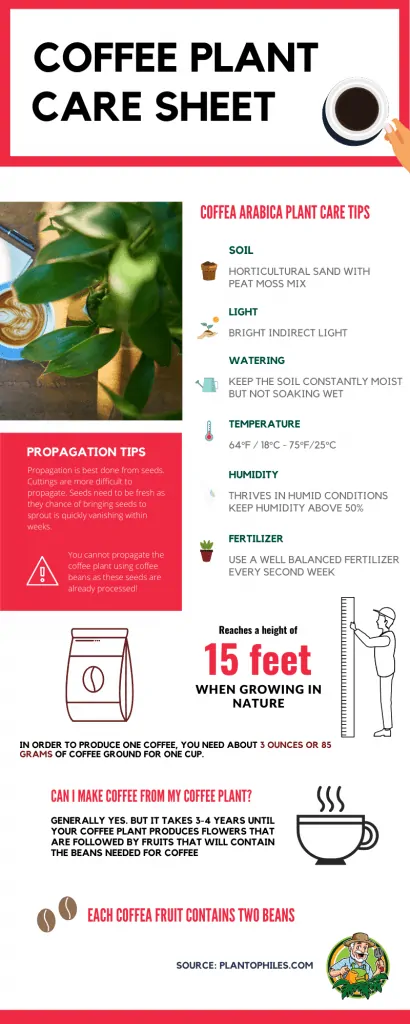
Coffee Plant Care Sheet
Frequently Asked Questions About the Coffee Plant (Coffea arabica)
Can I make coffee from my coffee plant?
Generally yes. But it takes 3-4 years until your coffee plant produces flowers that are followed by fruits that will contain the beans. To make coffee out of the seeds that are called coffee beans, you will need to be able to get your Coffee plant to bloom and produce fruits. Each fruit contains two beans. In order to produce coffee, you will need to roast the coffee beans. You will need about 3 ounces or 85 grams of coffee ground for one cup.
Can a Coffee plant be grown from the coffee you buy in the supermarket?
It is not possible to grow a plant out of the coffee beans you are buying in a supermarket as these coffee beans or seeds are already roasted (heat-treated) and will not produce a viable plant.
Is a coffee plant safe for cats?
Coffee plants are toxic to cats and cause vomiting and diarrhea.
Is a coffee plant safe for dogs?
Coffee plants are toxic to dogs and cause vomiting and diarrhea.
Is the coffee plant toxic?
Yes. All parts except the fruit and its seed that are processed into coffee beans are toxic to humans, cats and dogs and cause vomiting and diarrhea.
Where can I purchase a coffee plant?
Coffee plants can be bought on Amazon, your local garden center and from time to time at the local supermarket as well as at offline and online plant stores.
What are the different names for a Coffee plant?
Coffea, Coffea arabica, Coffea robusta.
Is a coffee plant a suitable houseplant for beginners?
Absolutely. Coffee plants are well suited for amateur growers and make a great and easy houseplant. They like bright indirect light and regular watering.
Why are the leaves of my coffee plant drooping?
Coffee plants are prone to whitefly, scale and mealy bugs. If you find these pests on your plants, spray a soapy mixture for 2 weeks.
Are coffee plants prone to pest infestation?
Mealybugs, aphids and mites are common pests that infect coffee plants. The coffee plant itself is prone to pest infestations. Small webs, powdery residues and small insects are visible signs of a potential pest infestation.
How many different coffee species are there?
There are 120 different coffee species. The most well known is Coffea arabica.
How to care for a Coffee plant?
Coffee plants do best in well-draining soil and like to be kept moist but not wet at all times. They prefer rather temperate climates and grow well in bright indirect light.

Daniel has been a plant enthusiast for over 20 years. He owns hundreds of houseplants and prepares for the chili growing seasons yearly with great anticipation. His favorite plants are plant species in the Araceae family, such as Monstera, Philodendron, and Anthurium. He also loves gardening and is growing hot peppers, tomatoes, and many more vegetables.

![#1 Coffee Plant Care Guide – [+Free Infographic to Download]](https://plantophiles.com/wp-content/uploads/2020/02/coffee-beans-1567389746ptu-728x410.jpg.webp)
